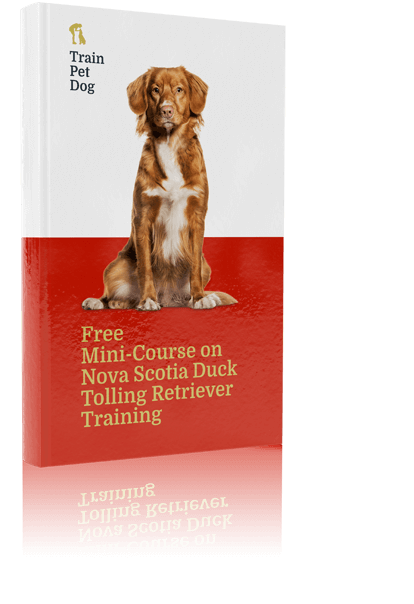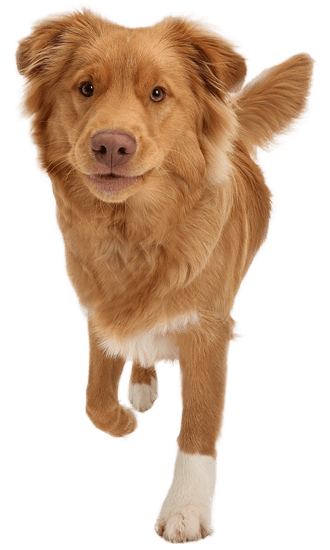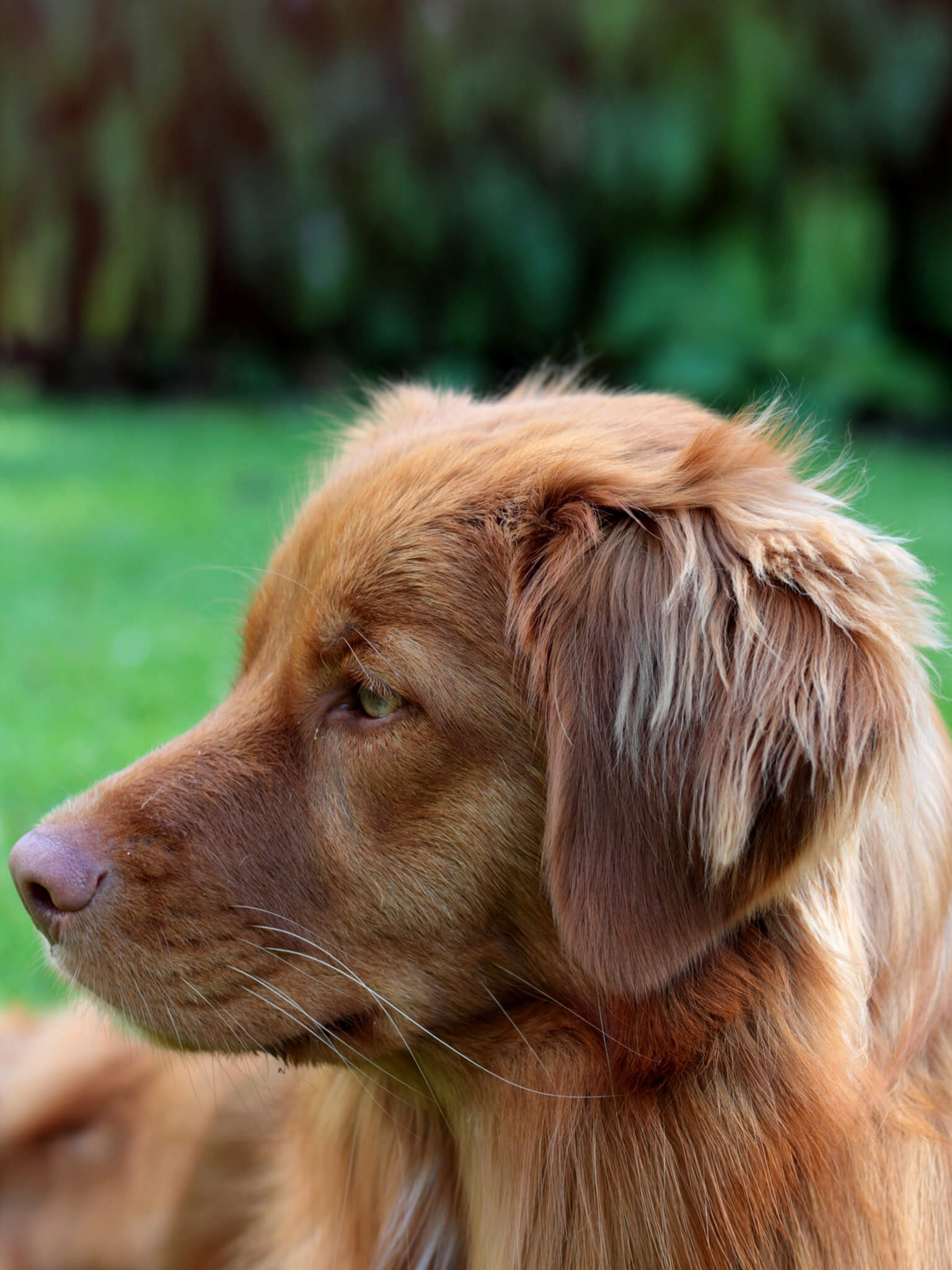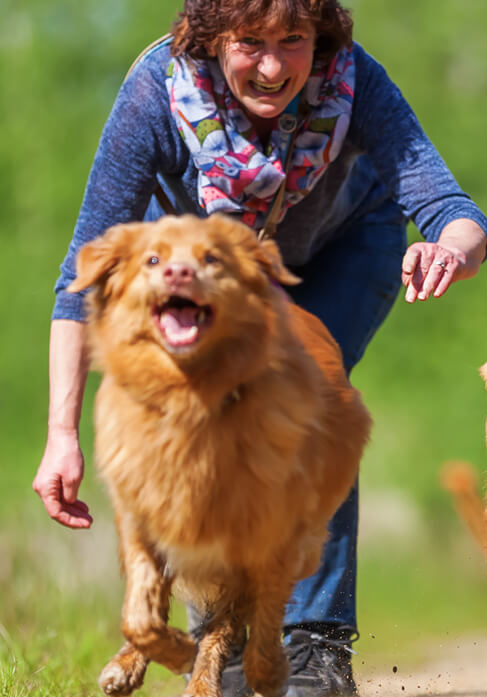Privacy Policy: Your email address is 100% safe.
We don't spam and hate it as much as you do :-) You can also unsubscribe from our mailing list at any time.

Sign Up
Nova Scotia Duck Tolling Retriever: Characteristics, Grooming, Health, Training (Toller)

Country of Origin, History of Nova Scotia Duck Tolling Retrievers
Nova Scotia Duck Tolling Retrievers come from Canada around Yarmouth and the Little River area of Nova Scotia. They are most likely a cross from Tolling Red Decoy Dogs with Retrievers and Spaniels. The Toller was bred to lure ducks within range of the hunters’ guns by dancing, splashing and swimming along the shore. The word ‘toll’ means ‘to lure.’
Once the ducks were shot, the Toller would retrieve them from the icy water. The technique of Tolling to bring ducks close to shore has been observed being done by families of foxes for centuries to capture a duck dinner, and the Nova Scotia Duck Tolling Retrievers red to orange coat was bred to mimic the fox colors.
Nova Scotia Duck Tolling Retriever Tools
Breed Selector Tool - is the Nova Scotia Duck Tolling Retriever the right breed for you?
Is the Nova Scotia Duck Tolling Retriever the right breed for you and your family?
Find out by using our Free Dog Breed Selector Tool
Check Your Nova Scotia Duck Tolling Retriever's Learning Style
Are you aware dogs also have a learning style that can greatly affect their ability to housetrain as well as be trained correctly. Evaluate your Nova Scotia Duck Tolling Retriever's learning style and personality using our free Learning Style tool so that you are better able to provide him with the proper Nova Scotia Duck Tolling Retriever training methods.
Is your Nova Scotia Duck Tolling Retriever dominating over you?
Does your Nova Scotia Duck Tolling Retriever bark unnecessarily? Does your Nova Scotia Duck Tolling Retriever come to you when you call? Download a FREE Report on Dog Dominance for you and your Nova Scotia Duck Tolling Retriever and learn how to control your dog.
Do you make these mistakes with your Nova Scotia Duck Tolling Retriever?
Are you inadvertently snow-balling bad behavior in your Nova Scotia Duck Tolling Retriever? Evaluate your Dog Training Style from our Free Tool and learn how best to deal with your dog.
Nova Scotia Duck Tolling Retriever Calorie Calculator
Do you know how many calories your Nova Scotia Duck Tolling Retriever needs every day and how many cups of food you should be giving it every day? Click here to use our Nova Scotia Duck Tolling Retriever Calorie Calculator.

A General Appearance of the Dog
The Nova Scotia Duck Tolling Retriever can remind you of a small Golden Retriever with white markings on its chest, feet, tail and sometimes on its head. The Nova Scotia Duck Toller is a medium sized, deep chested dog with a powerful, compact, well-muscled body on sturdy, solid legs. Tollers are determined, quick and alert, with the retriever desire to please.
Coat Color
A Nova Scotia Duck Tolling Retriever’s coat can be varying shades of Red or Orange and may have white markings on the feet, chest, head or tail.
Coat Type
Tollers were bread to retrieve from icy cold water and have a thick water-repellent double coat, with a dense undercoat. The topcoat is straight but may have a slight wave on their back.
Height
Males: 18 to 21 Inches (ideally
19”)
Females: 17 to 20 inches (ideally 18”)
Weight: 37 to 50 lbs
Do not overfeed as they tend to gain weight, especially if they do not get enough exercise.



Free Nova Scotia Duck Tolling Retriever Training Secrets
Free Course on Nova Scotia Duck Tolling Retriever Training & Obedience
Stop All Bad Behavior, Excessive Barking and Biting
Nova Scotia Duck Tolling Retriever Personality Traits

Temperament of the Dog
The Nova Scotia Duck Tolling Retriever is fun loving and very devoted to their family. They are intelligent and easy to obedience train. Tollers are good with children and will spend hours retrieving sticks or balls thrown for them. Nova Scotia Duck Tolling Retrievers are a bit more reserved than Golden Retrievers around strangers. Since barking would scare away the ducks, Tollers seldom bark unless they sense danger. These are very playful dogs. They get along well with all types of people and other family pets (NO ducks or waterfowl though).
Tolling (luring) is a natural trait and cannot be taught. The AKC recommends that all Nova Scotia Duck Tolling Retrievers be field tested for tolling.
Better suited to an indoor or outdoor lifestyle?
Duck Tolling Retrievers prefer a very active life style. They do fine indoors or in apartments but require daily, active exercise. They do well in cold weather.
Are they suited to homes with kids?
Nova Scotia Duck Tolling Retrievers are good with children. They love the activity level and are devoted family dogs. Somewhere in their background may be some herding instinct as they sometimes try to keep their family within bounds.
Nova Scotia Duck Tolling Retriever Activity Level
How Active is the Breed?
Extremely active, the Toller requires at least a brisk walk or jog daily. They are a high energy breed. Their idea of a good afternoon would be for someone to throw a ball or a stick for them to retrieve for hours. These are great agility and flyball and Frisbee® dogs.
How Much Exercise Does the Dog Need at every stage of its Life?
Nova Scotia Duck Tolling Retrievers stay active for most of their lives; they are an extremely active breed with lots of energy.
Grooming
The thick double coat requires brushing, with focus on the dense undercoat. The Duck Toller should not be bathed often as it removes the natural oils that make its coat water repellent.


Free Nova Scotia Duck Tolling Retriever Training Secrets
Free Course on Nova Scotia Duck Tolling Retriever Training & Obedience
Stop All Bad Behavior, Excessive Barking and Biting
Health and Care
Genetic Problems
In general the Toller is a healthy breed, but as their popularity has increased, there have been some instances of thyroid and autoimmune problems and progressive retinal atrophy (PRA).
Litter Size: 6 – 10 puppies
Life Span: 12 to 14 years
National Breed Clubs
National Breed Clubs
British – Nova Scotia Duck
Tolling Retriever Club (UK) – www.toller-club.co.uk
US – Nova Scotia Duck Tolling Retriever Club
(USA) - www.nsdtrc-usa.org
Other Recognition: CKC, FCI, UKC, CKC, NKC, NZKC, APRI, ACR
Rescue link: www.nsdtrc-usa.org/rescue.htm
Group: Sporting Dog group, KCGB Gun Dog Group.
AKC Popularity Ranking: 83
Also Known As: Little River Duck Dog, Yarmouth Toller
Train Your Nova Scotia Duck Tolling Retriever To Listen To You
Get Instant Access to Your Training Now - For Free
Sign up for our Free Nova Scotia Duck Tolling Retriever Mini Course to have a housebroken, obedient dog that happily comes to you every time you call.
You'll learn new commands to obedience-train your dog as well as how to housebreak your dog in 6 days or less.
You'll also learn how to eliminate bad habits like barking, nipping or biting, jumping, or pulling on the leash.Here's just s small fraction of what else you'll learn in the course:
How to lead and think like a pack dog - the new psychology.
3 dangerous mistakes that most Novie owners make when they are trying to potty train their dogs.
The 2 main reasons why your dog barks excessively and how to control its excessive barking.
How to obedience train your Nova Scotia Duck Tolling Retriever to permanently end behavioral problems like Jumping, Aggression, Pulling on Leash.
A surprisingly easy way to teach your dog cool new tricks.
How to improve your dog's lifespan and keep it from getting overly heavy with a healthy and nutritious diet.
Getting Pro help fast - how to get access to our expert trainers when you need them most.
One hidden psychological trigger that all Nova Scotia Duck Tolling Retrievers have... that practically allows you to "analyze" and "control" your dog's every action.
Priority access to the free online seminars conducted by our training experts.
Whereas other dog training related web sites and books offer generic information for dogs in general, ours is the ONLY web site that offers Novie information specifically, from a renowned panel of experts - because as you probably know, Novies have their own special training requirements that other dogs don't have.
Our Dog Experts
The Nova Scotia Duck Tolling Retriever training information you will read here was developed by a panel of renowned dog training experts whose combined wisdom represents nearly 100 years of specialist experience training dogs.
Here are a few of our experts:




